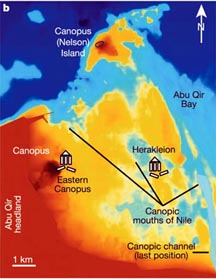

Field
Notes
by Emily D. Johnson
A tale of two cities
Last December scientists discovered evidence of three Egyptian cities:
Canopus, Herakleion and Menuthis (Geotimes,
December 2000). They were submerged six meters under the Nile’s surface
— shallow enough to snag the nets of local fishermen but deep enough to
absolve sea level rise of sole responsibility for making them sink. An
earthquake seemed a likely cause, but no seismic activity was recorded
for the middle of the eighth century — the date of the latest Arabic coins
found in the aquatic ruins.

Above: Eastern Canopus and Herakleion sat near the Canopic branch of the Nile, which flowed into western Abu Qir Bay. Over time, the branch channel and mouth migrated laterally, setting the stage for sediment failure. Orange < 4m water depth; yellow, 4-7 m; light blue, 7-12 m; dark blue, >12 m.
Now the mystery is solved, say Jean-Daniel Stanley of the Smithsonian and his collegues at the Institut Européen d’ Archéologie Sous-Marine, reporting in the July 19 Nature. They believe that, during a flood recorded around AD 741, the Nile rose more than a meter above normal flood levels. Weighty, turbulent, sediment-rich Nile waters piled upon soft, organic-rich, unstable muds, causing failure of the riverbank and the submergence of at least two of the cities.
According to a seventh-century text by Sophronius of Damas, Patriarch of Jerusalem, the cities did stand near the Nile’s shore, a vulnerable spot. And, say the researchers, sediment cores from the northwestern delta indicate that the Canopic branch of the Nile near these cities was unsteady, migrating from east to west and back again. Magnetometry also found several V-shaped trenches with cracks in the mud near the ruins, which the researchers interpret as post-depositional failure of mud-rich sediment.
Evolution debated in Hawaii
On July 26, a Hawaii Board of Education member proposed changing the
phrase “biological evolution” to “multiple theories of origin” in Hawaii’s
educational standards for science. The community protested immediately.
Local scientists were particularly vocal, and although they did not coordinate
their protests, e-mails sent through the Geology and Geophysics and Oceanography
departments at the University of Hawaii detailed the arguments against
the proposal and explained how to sign-up to speak at an Aug. 2 board meeting.
At the meeting, evolution supporters outnumbered opponents almost three
to one according to the level of applause coming from either side, says
University of Hawaii geologist Gerard Fryer, who was interviewed in the
local paper and TV station on the subject. After hearing three hours of
community debate between “evolutionists” and “creationists,” the board
voted unanimously to preserve the original wording and keep evolution as
the only theory of human origin taught in public school science classes.
Fryer summed up the feelings of his colleagues: “Theory means something
very specific in science. Creationism is not a theory.”
The rostral nostril
In the Aug. 3 issue of Science, Ohio University-Athens paleontologist
Lawrence Witmer writes that to accommodate hefty sinuses, the fleshy nostrils
on many dinosaurs were much farther from the eyes and closer to the mouths
than previously depicted. A rostral nostril would enhance the sense of
smell and help air flow through the nasal passages, bringing oxygen to
the blood and regulating brain temperature.
Witmer used dinosaur skulls and X-rays of skulls from 62 extant dinosaur relatives, including birds and lizards, to infer the location of cartilage, blood vessels and other soft tissues that make up the fleshy nostril as well as nasal cavities and passages. The largest passages were found in the horned dinosaurs Triceratops, in duck-billed dinosaurs, and in brontosaurs like Diplodocus, which was 80 to 90 feet long and weighed more than 40 tons.
 |
Geotimes Home | AGI Home | Information Services | Geoscience Education | Public Policy | Programs | Publications | Careers |